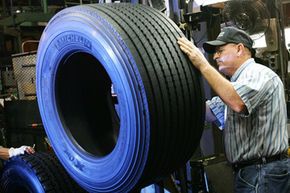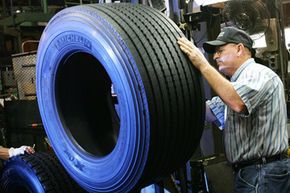\”

A lot of thought has gone into the latest automotive safety technology. Many people today wouldn\’t think of driving a car without things like electronic stability control, anti-lock brakes and airbags.
Yet, one of the most important safety features on a car is something most people don\’t even consider a safety feature: the tires.
The tires are what connect a car to the road. They provide the traction that allows the car to stop, move forward and turn. Having the wrong tires, or unsafe ones, on your car is like wearing the wrong shoes. Except, instead of just tripping and falling down, with the wrong tires, the consequences can be much more serious.
Tires have five main parts. The bead is actually a steel cable that\’s wrapped in rubber. It goes along the inside edge of the tire, holding the tire to the wheel. The body of the tire is made up of layers of strong fabric. Each layer is called a ply. The more plies, the stronger the tire. Some tires have steel belts under the tread and those types of tires are called steel-belted radials. The steel belts help make the tire more resistant to punctures. Plus, the belts also help keep the tire slightly flat, which increases the amount of rubber in contact with the road. That increases vehicle traction, making the car more surefooted. The sidewall is the side-edge of the tire. It keeps all the inner parts tightly compacted. And the tread is the rubber part of the tire that actually makes contact with the road.
While most tires have these basic parts, there are many different types of tires available, and with many designations. Because tires come on all cars, and they\’re such an important safety feature, you may be wondering if some tires are safer than others. Keep reading to find out.
Different Tires and Different Features


There are lots of different tires on the market today. You can get everything from racing slicks to mud and snow tires — not to mention the all-season tires most new cars come with. When it comes to tire safety the safest tires are the ones that are well-matched to your vehicle and those that are properly maintained.
Having tires that are well-matched to your vehicle means a couple of things. First and foremost, it means having tires that fit your car. Putting the wrong size tires on a car can adversely affect the car\’s handling and maneuverability. Plus, different tires have different weight ratings. If you put tires on a car that can only handle a certain amount of weight and your car exceeds that amount, it\’s a recipe for disaster. Beyond fitting the car, tires need to also fit how a driver intends to use his or her car. If you\’re driving through mud, snow or other conditions that reduce traction, you\’ll need a tire that can make up for the traction loss, like mud and snow tires. If you drive in the rain, you\’ll need tires with a traction pattern that channels water safety way from the tire\’s contact patch with the road. If the tire can\’t effectively move the water out of its way, then the driver runs the risk of hydroplaning and losing control.
While the choosing the right tire is important, so is maintaining it. Tires that are badly worn will have limited contact with the road, and what contact they do have will be less grippy. Plus, if a tires treads are worn down, they\’ll be less able to channel things like water, snow and ice, away from the tire, which increases the risks of skids. Tires that are under- or over-inflated also increase crash risk because they aren\’t making optimal contact with the road, not to mention that it\’s easier to puncture and blow out an over-inflated tire.
The best way to maintain your tires and make sure they\’re safe is by checking once a month to ensure that they\’re properly inflated. Have your tires rotated regularly. You should also visually inspect your tires on a regular basis. Look for things like flaky rubber or debris embedded in the tire. Finally, check the tread wear using the penny test: Take an ordinary copper penny and place it into your tire\’s tread with Lincoln\’s head pointed down. If you can see any space between Lincoln\’s head and the edge of the penny, your tire\’s tread is too thin. It\’s time for new tires.
So, are some tires safer than others? The short answer is yes. The safest tires are ones that are well-matched to the vehicle they\’re on as well as the type of use they\’re subjected to and those that are well-maintained.
For more information about tires and other related topics, follow the links on the next page.
Lots More Information
Related Articles
- 5 Things to Look For in a New Tire
- 5 Warning Signs You Need New Tires
- Car Smarts: Tires
- How Tires Work
- How Q Tires Work
- How Self-inflating Tires Work
- How Self-regenerating Tire Tread Works
- How Tire Traction Works
- How the Tweel Airless Tire Works
- What is an eLSD?
Sources
- National Highway Traffic Safety Administration. "Tire Ratings." (Aug. 3, 2010) http://www.safercar.gov/portal/site/safercar/menuitem.13dd5c887c7e1358fefe0a2f35a67789/?vgnextoid=65ba4507fe526110VgnVCM1000002fd17898RCRD
- National Highway Traffic Safety Administration. "Tire Size." (Aug. 3, 2010) http://www.safercar.gov/portal/site/safercar/menuitem.13dd5c887c7e1358fefe0a2f35a67789/?vgnextoid=87e7cf6677526110VgnVCM1000002fd17898RCRD
- Road and Travel Magazine. "Penny Test to Check Tire Tread." (Aug. 3, 2010) http://www.roadandtravel.com/carcare/2005/tiretread.htm
- Tirerack.com. "Selecting the Right Tires." (Aug. 3, 2010) http://www.tirerack.com/tires/tiretech/techpage.jsp?techid=31












